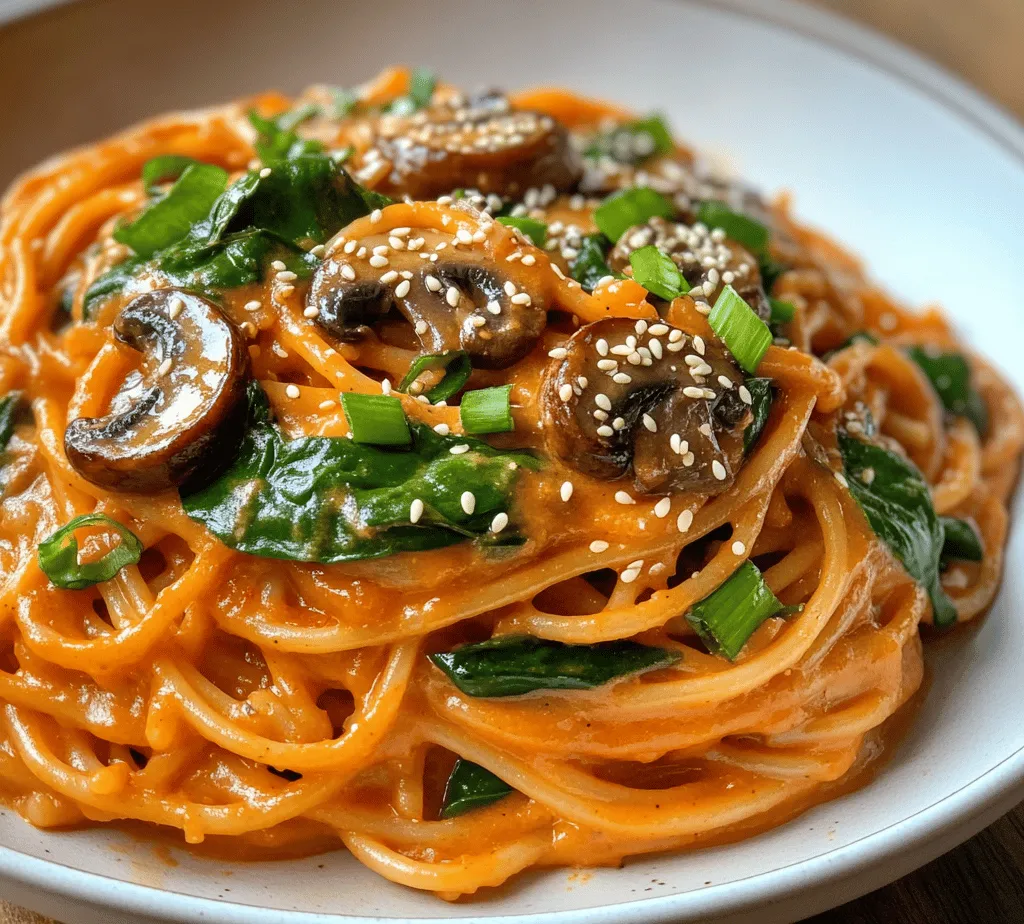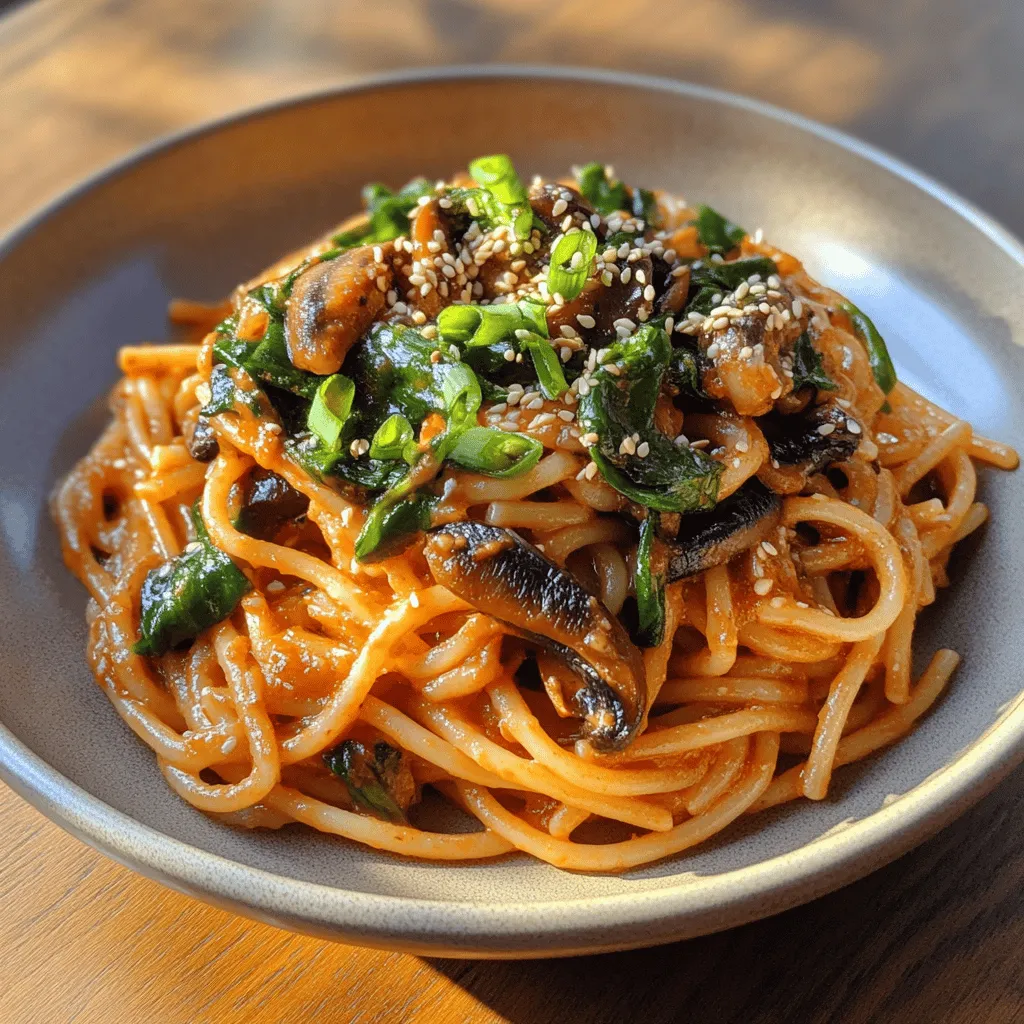In recent years, the culinary world has seen an exciting trend where traditional recipes are given a modern twist by combining flavors and techniques from different cultures. One dish that perfectly exemplifies this fusion is Creamy Korean Ssamjang Pasta. This innovative recipe marries the rich, tangy flavors of ssamjang—a popular Korean dipping sauce—with the comforting, creamy texture of a classic pasta dish. The result is a delightful combination that tantalizes the taste buds, offering a fresh take on both Korean and Italian cuisines.
Creamy Korean Ssamjang Pasta not only serves as a delicious meal but also showcases the versatility of ssamjang, elevating it from a simple condiment to the star of a hearty, satisfying dish. In this article, we will explore the intricacies of this delightful recipe, including its background, primary ingredients, and the essential steps needed to create this culinary masterpiece.
Understanding Ssamjang: The Heart of the Dish
Exploring the Origins of Ssamjang
At the core of this fusion pasta dish is ssamjang, a thick, savory sauce that is a staple in Korean cuisine. Traditionally, ssamjang is a mixture of doenjang (fermented soybean paste) and gochujang (Korean chili paste), along with additional ingredients such as sesame oil, garlic, and sugar. This unique combination results in a condiment that is rich in umami, with a perfect balance of sweetness and heat.
Ssamjang is often used as a dipping sauce for grilled meats and fresh vegetables, particularly during Korean BBQ. Its versatility, however, extends well beyond the grill; it can also be incorporated into various dishes, from stews to marinades, providing a depth of flavor that enhances everything it touches. This dish takes ssamjang and elevates it into a creamy pasta sauce, making it an exciting addition to your culinary repertoire.
Health Benefits of Ssamjang
Beyond its flavor, ssamjang offers several health benefits that make it a smart choice for those looking to enhance their meals. Rich in probiotics due to the fermentation process, ssamjang can support gut health and aid digestion. It also contains antioxidants that help combat oxidative stress in the body.
Moreover, the primary ingredients of ssamjang, such as soybean paste, provide high-quality protein and essential nutrients. By incorporating ssamjang into your diet, you’re not only enriching your dishes but also promoting overall well-being.
Ingredient Breakdown for Creamy Korean Ssamjang Pasta
Creating the perfect Creamy Korean Ssamjang Pasta requires a thoughtful selection of ingredients. Each component plays a crucial role in establishing the dish’s distinctive flavor profile and texture.
The Essential Ingredients
Pasta Base: Choosing the Right Type of Pasta
The foundation of any pasta dish lies in the choice of pasta. For Creamy Korean Ssamjang Pasta, you can opt for various types, such as spaghetti, fettuccine, or penne. The key is to select a pasta that can hold the creamy sauce well. Long, thin pasta like spaghetti allows the sauce to coat each strand evenly, while wide pasta like fettuccine offers a hearty base that complements the richness of the dish.
If you’re looking for a gluten-free option, consider using rice noodles or gluten-free pasta made from chickpeas or lentils. These alternatives not only cater to dietary restrictions but also bring their unique flavors to the dish.
Ssamjang: The Flavorful Foundation
The star of this dish is, of course, ssamjang. The quality of ssamjang you choose will significantly affect the overall flavor of the pasta. Look for high-quality ssamjang that boasts a balanced sweetness and heat. Different brands may vary in intensity, so it’s worth experimenting to find one that suits your palate.
You can find ssamjang at most Asian grocery stores or online, but if you’re feeling adventurous, you can also make your own by blending doenjang, gochujang, sesame oil, minced garlic, and a touch of sugar. This homemade version allows you to customize the flavors to your liking.
Cream and Seasonings
To achieve that creamy texture that defines this pasta dish, heavy cream is essential. It lends a luxurious mouthfeel to the sauce, allowing it to envelop the pasta beautifully. If you’re looking for a lighter alternative, you can use half-and-half or full-fat coconut milk for a dairy-free option.
In addition to cream, a touch of honey or sugar can be added to balance the flavors, cutting through the spiciness of the ssamjang. This sweetness enhances the overall complexity of the dish, creating a harmonious blend of flavors.
Fresh Elements: Mushrooms and Spinach
No pasta is complete without fresh ingredients, and for Creamy Korean Ssamjang Pasta, shiitake mushrooms and baby spinach add both texture and nutrition. Shiitake mushrooms contribute an earthy flavor that complements the umami notes of ssamjang, while baby spinach offers a burst of color and vital nutrients.
You may also consider adding other vegetables, such as bell peppers or zucchini, to enhance the dish’s nutritional profile and introduce additional flavors. The key is to use fresh, seasonal ingredients that will elevate your pasta to the next level.
Step-by-Step Guide to Making Creamy Korean Ssamjang Pasta
With the ingredients gathered, it’s time to dive into the cooking process. Below is a detailed guide to making Creamy Korean Ssamjang Pasta from start to finish.
Preparing the Pasta
Begin by bringing a large pot of salted water to a boil. The salt will help to flavor the pasta as it cooks. Once the water is boiling, add your chosen pasta and cook it according to the package instructions until it reaches al dente perfection. This usually takes about 8 to 10 minutes, depending on the type of pasta.
Make sure to reserve about one cup of the pasta water before draining the pasta. This starchy water will be crucial for achieving the desired consistency of your sauce later on. After draining, set the pasta aside while you prepare the sauce.
Sautéing Aromatics for Depth of Flavor
In a large skillet over medium heat, add a drizzle of oil and allow it to heat up. Once hot, add finely chopped onions and minced garlic. Sauté these aromatics until they become translucent and fragrant, which should take about 3-4 minutes. This step is essential as it builds the flavor base for your creamy sauce.
The combination of onions and garlic not only adds depth to the dish but also enhances the overall aroma, making your kitchen smell irresistible.
Cooking the Mushrooms
Next, add sliced shiitake mushrooms to the skillet. Cook them for about 5-7 minutes until they release their moisture and turn golden brown. The caramelization of the mushrooms will intensify their flavor, providing a delicious contrast to the creaminess of the sauce.
Once the mushrooms are cooked, it’s time to add the baby spinach. Toss it in and cook for another 2-3 minutes, just until the spinach wilts. This will ensure that the fresh flavor of the spinach is preserved while still contributing its nutrients to the dish.
With the mushrooms and spinach prepared, you’re ready to combine all the elements for the Creamy Korean Ssamjang Pasta. Stay tuned for the next section, where we will delve into the final steps of assembling this exciting dish!

Sautéing Shiitake Mushrooms for Maximum Flavor
To elevate your Creamy Korean Ssamjang Pasta, the sautéing of shiitake mushrooms is a crucial step that should not be overlooked. These mushrooms not only contribute a delightful umami flavor but also add a rich texture to the dish. Begin by cleaning your shiitake mushrooms with a damp cloth to remove any dirt. Avoid rinsing them under water, as mushrooms tend to absorb moisture, which can make them soggy.
Heat a tablespoon of olive oil in a large skillet over medium-high heat. Once the oil is shimmering, add the sliced shiitake mushrooms in a single layer. It’s essential to avoid overcrowding the pan; if necessary, sauté in batches. Allow the mushrooms to cook undisturbed for about 3-4 minutes, which helps them develop a beautiful golden-brown color. This caramelization process is key to unlocking their full flavor potential. After achieving that desirable color, stir occasionally for an additional 2-3 minutes until they are tender and fragrant. Season lightly with salt and pepper to enhance their natural flavors. Once done, transfer the mushrooms to a plate and set them aside while you prepare the creamy sauce.
Crafting the Creamy Sauce
The star of the show in Creamy Korean Ssamjang Pasta is undoubtedly the creamy sauce, which brings together the unique flavors of ssamjang with the richness of heavy cream. Start by placing a medium-sized saucepan over low heat and adding a cup of heavy cream. Slowly heat the cream, being careful not to let it boil, as this can affect the texture.
Next, add in 2 tablespoons of ssamjang, which is a Korean fermented soybean paste mixed with chili powder, garlic, and sesame oil. This ingredient is what adds that signature depth and spiciness to the sauce. Whisk the ssamjang into the cream until fully combined. At this stage, you can adjust the thickness of the sauce to your liking. If you prefer a thicker sauce, allow the mixture to simmer gently for a few minutes until it reduces slightly. For a thinner consistency, simply stir in a splash of pasta water or additional cream as needed.
To enhance the flavor further, incorporate a teaspoon of minced garlic and a pinch of black pepper into the sauce. Allow the mixture to simmer on low heat for about 4-5 minutes, which helps meld the flavors together. Taste the sauce and adjust the seasoning as necessary, adding more ssamjang for heat or salt for balance.
Incorporating Greens for Color and Nutrition
Adding greens to your Creamy Korean Ssamjang Pasta not only enhances the dish’s visual appeal but also boosts its nutritional value. Baby spinach is an excellent choice due to its mild flavor and quick cooking time. After preparing your creamy sauce, it’s time to incorporate the spinach.
In the same skillet used for the mushrooms, add a small amount of olive oil over medium heat. Once heated, toss in about 2 cups of baby spinach. Sauté the spinach for just 1-2 minutes, stirring frequently until it wilts but remains vibrant green. This brief cooking time ensures that the spinach retains its nutrients and bright color, making your dish not only delicious but also visually stunning.
Combining Pasta and Sauce
Now that you have your pasta cooked to al dente perfection, the next step is to combine it with the creamy sauce and sautéed shiitake mushrooms. Reserve a cup of the starchy pasta water before draining the pasta, as this can be useful for achieving the desired sauce consistency later.
In the skillet with the creamy sauce, add the drained pasta, shiitake mushrooms, and sautéed spinach. Using tongs, gently toss the pasta in the sauce, ensuring that every strand is evenly coated. If you find the sauce is too thick, gradually add pasta water, a little at a time, until you reach your preferred consistency. The goal is a luscious, creamy mixture that clings beautifully to the pasta.
Garnishing and Serving Suggestions
The Art of Presentation
Presentation is key when serving Creamy Korean Ssamjang Pasta. To create an inviting dish, consider using a large, shallow bowl or a plate with a slight rim. Twirl the pasta into a nest-like shape in the center of the plate for an elegant touch. For garnish, sprinkle toasted sesame seeds and finely chopped green onions over the top. These not only enhance the visual appeal but also add a delightful crunch and fresh flavor that balances the creaminess of the dish.
Pairing Suggestions
To further enhance your dining experience, think about what to serve alongside your Creamy Korean Ssamjang Pasta. A light, refreshing salad featuring seasonal greens and a tangy vinaigrette can serve as a perfect counterpoint to the rich pasta. If you prefer a heartier option, grilled or roasted vegetables, such as zucchini or bell peppers, will harmonize beautifully with the flavors of the dish.
For beverages, a crisp white wine such as Sauvignon Blanc or a light lager can complement the dish nicely. Alternatively, for a non-alcoholic option, consider serving a chilled herbal iced tea or a sparkling water with a twist of lime.
Cultural Significance and Culinary Fusion
The Trend of Korean-Italian Fusion
The fusion of Korean and Italian cuisines reflects a broader trend in modern culinary arts, where traditional boundaries are blended to create innovative and exciting dishes. Creamy Korean Ssamjang Pasta exemplifies this trend by combining the robust flavors of Korean ssamjang with the comforting familiarity of Italian pasta. This culinary crossover not only tantalizes the taste buds but also represents a cultural exchange that invites home cooks to explore new flavors and techniques.
The appeal of fusion dishes lies in their ability to introduce diverse cultural elements into everyday cooking, inspiring creativity and experimentation in the kitchen. Creamy Korean Ssamjang Pasta is not just a meal; it embodies a celebration of culinary diversity that resonates with food enthusiasts around the world.
Exploring Other Fusion Recipes
For those intrigued by the concept of fusion cuisine, there are numerous other dishes to explore. Consider trying Korean Tacos, where spicy bulgogi beef is served in soft tortillas, or Kimchi Fried Rice, which incorporates the iconic Korean fermented vegetable into a classic stir-fried rice dish. Each of these recipes showcases the harmonious blending of flavors and techniques from different culinary traditions, encouraging adventurous home cooks to broaden their horizons.
Nutritional Overview of Creamy Korean Ssamjang Pasta
Caloric Breakdown
When it comes to enjoying Creamy Korean Ssamjang Pasta, understanding its nutritional content can help you make informed choices. A standard serving of this dish typically contains around 500-600 calories, depending on the specific ingredients and portion sizes used. The creamy sauce contributes a significant amount of calories, primarily from fats, while the pasta provides carbohydrates and some protein.
In terms of macronutrients, you can expect approximately 15-20 grams of protein, 30-35 grams of fat, and 50-60 grams of carbohydrates per serving. These values can vary based on any modifications made to the recipe, such as using whole grain pasta or reducing the amount of cream.
Healthier Modifications
For those looking to make healthier modifications to the Creamy Korean Ssamjang Pasta, there are several options worth considering. Substituting traditional pasta with whole grain or legume-based pasta can increase fiber content and improve overall nutritional value. Additionally, using plant-based cream or low-fat alternatives can reduce calories and fat without sacrificing creaminess.
Incorporating more vegetables, such as broccoli or bell peppers, can enhance the dish’s nutritional profile while adding vibrant colors and textures. For those with dietary restrictions, using gluten-free pasta or ensuring all ingredients are vegan can accommodate a variety of preferences.
Conclusion: Embracing the Unique Flavor of Creamy Korean Ssamjang Pasta
In conclusion, Creamy Korean Ssamjang Pasta stands as a testament to the exciting possibilities of culinary fusion. By marrying the robust, spicy notes of ssamjang with the comforting creaminess of traditional pasta, this dish offers a unique exploration of flavors that bridges two distinct culinary traditions. The combination of fresh vegetables, rich sauce, and perfectly cooked pasta creates a meal that is both comforting and exhilarating, perfect for any occasion.
Whether you are a seasoned chef or a new home cook, this recipe invites you to experiment with flavors and techniques, celebrating the vibrant nature of modern cooking. Embrace the innovative spirit of this dish, and share the joy of fusion cuisine with friends and family. With its intriguing blend of textures and tastes, Creamy Korean Ssamjang Pasta promises to be a delightful addition to your dining repertoire.



